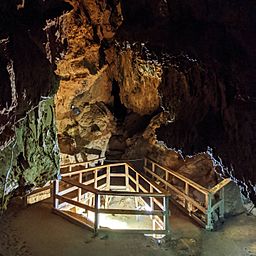The Caverns at Natural Bridge facts for kids
The Caverns at Natural Bridge are amazing underground caves in the Shenandoah Valley of Virginia. They are close to the famous Natural Bridge and Natural Bridge State Park. These caverns were found in the 1890s. They first opened for visitors in 1978.
The Caverns at Natural Bridge are the deepest caves you can visit on the East Coast. They are also home to two special creatures. One is a beetle called the Natural Bridge Cave Beetle. The other is a tiny water bug known as the Natural Bridge Isopod. These animals are found nowhere else in the world!
Contents
Exploring the Caverns: What to See
You can take a guided tour to explore these cool caverns. Some tours even use lanterns, which makes the experience extra special! A typical tour lasts about 45 minutes.
Inside the Caverns: Temperature and Features
The temperature inside the caverns stays a cool 54 °F (12 °C) (about 12°C) all year. This makes it a great place to visit, even on a hot day! The caverns have many unique rock formations. You can see amazing sights like the Colossal Dome Room, Mirror Lake, the Well Room, and the Canyon Room. The very deepest part of the cavern is 347 feet (106 meters) below the ground. That's like going down a 30-story building!
Past Names of the Caverns
Before they were known as The Caverns at Natural Bridge, these caves had a different name. They were once called Buck Hill Caverns.
How the Caverns Were Discovered
The Caverns at Natural Bridge were found by two brothers, Jake and Joe Fitzgerald. This happened in the late 1800s. At that time, the land belonged to a man named Colonel Henry Chester Parsons. He was also involved with the opening of the famous Natural Bridge landmark.
The Science Behind the Caves: Geology
The Shenandoah Valley where these caverns are located has a lot of limestone rock underground. This area also has something called karst topography. This is a special type of landscape where caves, sinkholes, and springs form easily.
How Caves Form
When rainwater falls, it picks up a tiny bit of acid as it goes through the soil. This slightly acidic water then seeps into cracks in the limestone. Over a very long time, this weak acid slowly dissolves the calcium carbonate in the limestone. This process creates the amazing caves and underground passages you see today. Because of this, there are many caves and caverns all around the Natural Bridge area.


